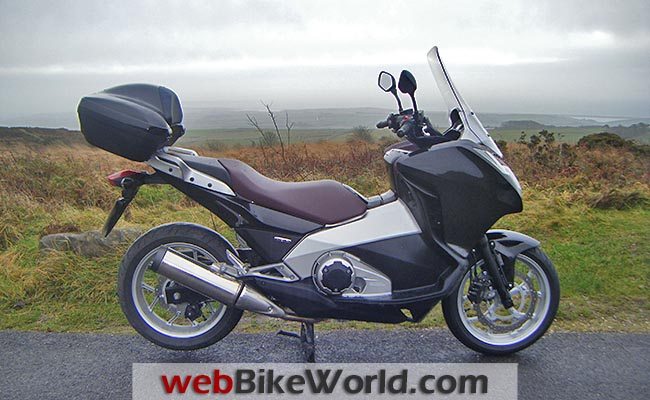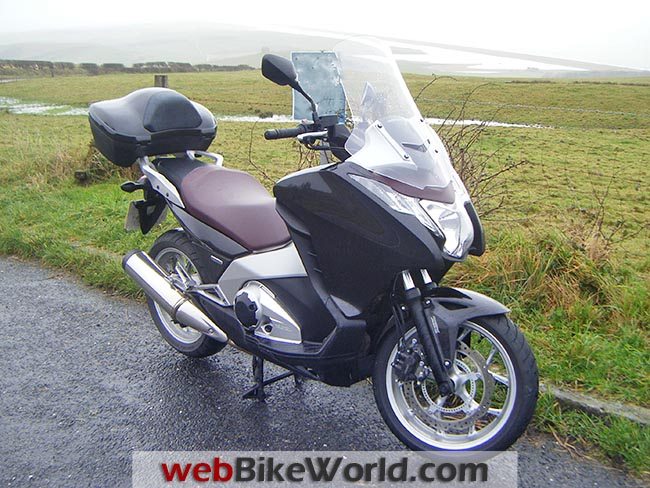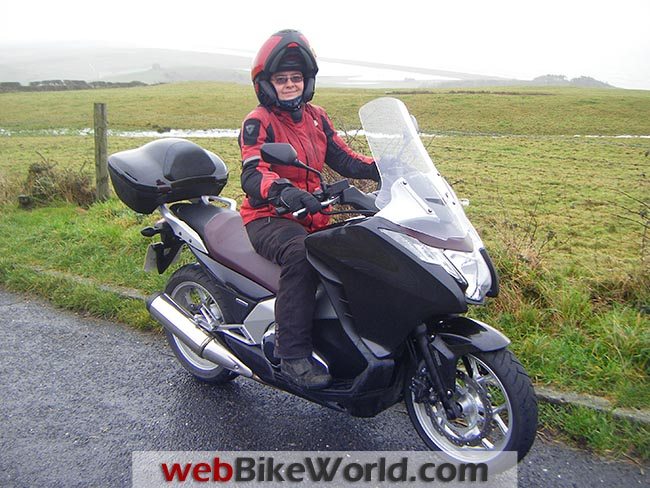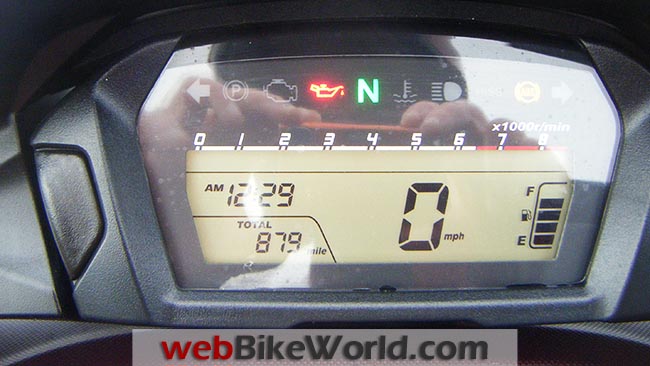First Ride: Honda NC700D Integra
In 2012, the maxi-scooter world saw the launch of two potential game changers: BMW’s luxurious C650 GT (review) and C600 Sport and Honda’s innovative Integra.
A few weeks after test riding BMW’s brace of beauties (“BMW C 600 Sport vs. C 650 GT“), I turned my attentions to Honda.
The Japanese manufacturer has a long history of scooter production, and the legacy of the successful Silver Wing series is obvious in the Integra’s styling.
Elsewhere, though, things are very different.
The Honda NC700D Integra, to give it its full name, shares its transmission and many components — everything lower than the seat, essentially — with its motorcycle siblings, the nakedNC700S and the adventure-style NC700X.
Its motorcycling heritage is visible in aspects like the huge (for a scooter) 17-inch wheels and the chain drive. Chain drive on a scooter?
And rather than the scooter-typical Continuously Variable Transmission (CVT), the Integra has a hybrid semi-automatic system, similar to that found on the Suzuki Burgman and Aprilia Mana 850 GT (review).
The Integra can be ridden in one of two auto modes, Sport or Drive, but there’s also the option to change gear manually using push-buttons on the left handlebar (the other models in the NC700-series are available in fully manual or the more expensive semi-automatic configuration).

Riding the Honda Integra NC700D
It’s easy to switch between automatic and manual, and between the two automatic modes, while riding. In auto mode, you can use the gear selector buttons to change up or down if, for instance, there’s a speed limit coming up, or you want to overtake.
In manual mode, the bike will still change down automatically if the revs drop too much — a bike that’s impossible to stall!
After I’d had these points, and the controls, explained to me by Honda of Bournemouth, it was time to go for a ride, escorted by my partner “H” on his VFR.
I was immediately concerned about the seat height. At 790 mm, it looked taller than my Gilera GP800, which is difficult for me to flat-foot, and I found myself not so much mounting and dismounting as scrambling up and down its slopes.
Luckily, the Integra is so well balanced I rarely needed to put my feet down; it will roll along almost indefinitely at very low speeds, and I found I was able to cruise in a straight line with my hands off the bars for several seconds. Honda worked hard to keep the centre of gravity low, and it shows.
The Integra is easy to manouevre when pushing, which is important for me as I’m too short to sit on a bike and paddle, and a doddle to roll on and off the centre stand.
The side stand I found trickier, especially when I tried to operate it while on the bike. In fact it’s difficult to tell when mounted whether the stand is up or down. That’s how I discovered a way in which the Integra differs from most conventional bikes and scooters: with the side stand down, the bike will start, but won’t go out of neutral. (Yes, it has a neutral!).

Honda NC700D Integra Seat and Details
The seat is wide, adding to the difficulty when putting my feet down, and rather firm, although I found it comfortable. The riding position is upright, which suits my usual riding style. Feet can be placed flat on the footboards or slightly forward and up; I preferred the latter.
The small digital dashboard is clear and concise: dominated by a large speedo on the left, followed by mode and gear information and a fuel gauge (which flashes red when it’s low) on the right, with a rev counter running along the top. A row of the usual lights (indicators, ABS, service light, etc.) is above the dash, though, strangely, there doesn’t seem to be a fuel light, only the digital warning. The gauge doesn’t really have enough bars to give a clear picture of how much fuel remains.
The windscreen is quite tall and isn’t adjustable, but I could see over it fine, and despite its narrow width it seemed to do a good job of keeping the wind off my head and hands.
Integra Storage?
The biggest complaint I heard about the Integra prior to launch, and the one thing which seemed to make it “not a proper scooter” in some eyes, was the woeful storage provision.
The under-seat storage area is designed to take a helmet, its domed shape contributing to the height and hardness of the saddle. I didn’t test it with mine, but suspect my flip front would be too bulky; I’d be more likely to use the space to store a chain and padlock. There’s also a helmet hook which allows you to secure a lid to the outside of the bike; I wouldn’t risk this with my BMW helmet, or in London, but elsewhere, or with a less attractive helmet I might.
There’s a titchy glovebox, too, perhaps roomy enough for a bag of sweets, a glasses case or a side stand puck.
An OEM top box and panniers are available, but they’re not cheap: the top box is nearly £300, and that’s before you add the rack and fitting kit. The top box is rather shallow, with a hump in the centre to take a helmet.

The Test Ride
We had picked a clear, bright winter morning for our test ride, the roads dry and largely free of salt and grit. As we left the traffic behind and hit the open road, I found I was enjoying myself a great deal, despite all the new sensations and controls I had to deal with.
The Integra doesn’t have the lightning pull away from stationary of a CVT, and I missed that instant acceleration when moving between speed limits or overtaking. I imagine that in manual mode, with a bit of practice, I would learn to harness the full power of the bike and speed things up.
A Scooter With a Chain
I didn’t try changing gear manually, as I was too busy getting to grips with a new bike. I switched between Sport and Drive a few times, but noticed little difference other than Drive usually selecting the next gear up from Sport.
Honda recommend “Drive” for motorways and urban riding and “Sport” for the twisties. This sounds like a fun experiment for the future! The shifting gears are noticeable when riding as an automatic, and I found it a little disconcerting, especially in low-speed traffic when it switched frequently between first and second.
Moving on to country back roads, we encountered some muddy stretches and large puddles left over from the previous day’s rain. I was surprised how confident I felt tackling all this on an unfamiliar vehicle, and when conditions became more pleasant I attacked the ride with renewed vigour. When we stopped for sandwiches, I couldn’t wait to get back on!
The mud did highlight the fact that a rear hugger — available as an optional extra — would be desirable, however.
Riding the Integra was hard work, but enjoyable, and I can see practice paying off. The seat height, which felt like a deal-breaker at first, can be worked around. I’ve also been hankering after some of Honda’s legendary reliability, after increasingly lousy experiences with my beloved Italian scooters.
And the very bike I’d been riding, Honda of Bournemouth’s demonstrator, was for sale, with 800 miles on the clock and more than a grand off the retail price of a new one.
The bike was right. The price was right. Reader, I married it. Er, bought it, rather!
Honda Integra Resources
- Honda UK Honda Integra Page
- Honda Integra Accessories Brochure (.pdf)
- Honda NC700D Integra Information (Wikipedia)
- Honda Integra Introduction (Automobile Magazine)

| Honda Integra Specifications | |
|---|---|
| Fuel Consumption | 17.3 m/l (78.6 mpg) |
| Maximum Torque | 62Nm/4,750min-1 95/1/EC |
| Bore x Stroke | 73 x 80 mm |
| Fuel Tank Capacity | 14.1 litres |
| Carburation | PGM-FI electronic fuel injection |
| Engine Type | Liquid-cooled 4-stroke 8-valve, SOHC parallel 2-cylinder |
| Ignition System | Computer-controlled digital transistorised with electronic advance |
| Engine Displacement | 670 cm3 |
| Maximum Power Output | 38.1 kW/6, 250 min-1 95/1/EC |
| Transmission Type | 6-speed Dual Clutch Transmission |
| Clutch Operation | Push button – D mode/S mode/Manual mode |
| Final Drive | Chain |
| Clutch | Wet, multiplate hydraulic 2-clutch |
| Wheelbase | 1,525 mm |
| Ground Clearance | 135 mm |
| Kerb Weight | 238 kg |
| Frame type | Diamond; steel pipe |
| Dimensions (LxWxH) | 2,195 x 790 x 1,440 mm |
| Seat Height | 790 mm |
| Tyre Size Rear | 160/60-ZR17M/C (69W) |
| Wheels Front | Multi-spoke cast aluminium 17M/C x MT3.5 |
| Brakes Front | 320mm single wavy hydraulic disc. 3-piston calipers. Sintered metal pads. |
| Brakes Rear | 240mm single wavy hydraulic disc. single-piston caliper. Sintered metal pads. |
| Anti-Lock Braking System | C-ABS as standard. |
| Tyre Size Front | 120/70-ZR17M/C (58W) |
| Suspension Front | 41 mm telescopic fork, 120 mm travel |
| Suspension Rear | Monoshock damper, Pro-Link swingarm, 120 mm travel |
| Wheels Rear | Multi-spoke cast aluminium 17M/C x MT3.5 |
Publication Date: December 2012
More wBW Motorcycle Reviews
Owner Comments and Feedback
See details on submitting comments.
From “G.P.” (February 2013): “Like Alice, I live in the UK and am a typical UK shorty — think Hobbit! I sat on the NC and whilst it looks and feels great, the fact that one has to swing one’s leg over rather than slide one’s leg across means it is a non-starter to those of us with back problems.
Also the under-seat storage does not match that of a traditional scooter. I can just about see the appeal to motorcyclists but not to scooter riders generally.
Honda have announced a 300 cc Forza scooter for 2013 in the UK…why oh why didn’t they create a replacement to their 600 cc twin Silver Wing Scooter?
I have ridden motorbikes and scooters for some 50 years, my current ride is a 600cc Yamaha TMAX scooter which is the nearest to a motorbike scooter I have come across.”
From “K.S.” (December 2012): “Thanks to Alice for this review. Noting that she currently rides the Gilera GP 800, it would be of interest to the readers when she tries out the new Aprilia SRV 850. This bike is Aprilia’s attempt to combine/market the best of the Gilera, and the Mana, as its (and Piaggio’s) current maxi-scooter styled entry.
And, importantly, how would it compete/contrast against the new BMW and Honda entries, both of which wBW has now reviewed?”









No Comment